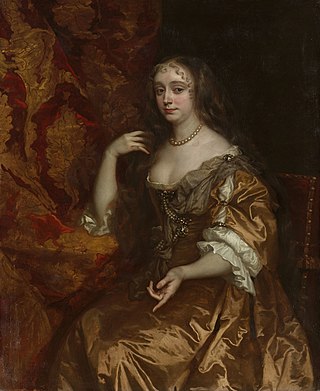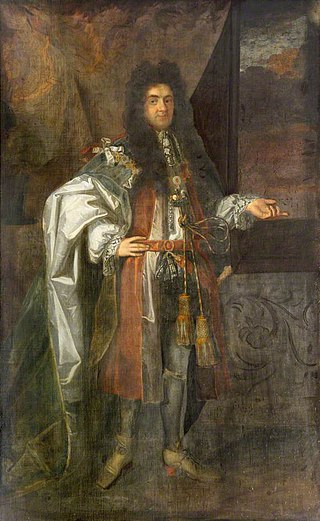
Edward Hyde, 1st Earl of Clarendon, was an English statesman, lawyer, diplomat and historian who served as chief advisor to Charles I during the First English Civil War, and Lord Chancellor to Charles II from 1660 to 1667.

Anne Hyde was Duchess of York and Albany as the first wife of James, Duke of York, who later became King James II and VII.

Earl of Clarendon is a title that has been created twice in British history, in 1661 and 1776.

Robert South was an English churchman who was known for his combative preaching and his Latin poetry.

Edward Montagu, 1st Earl of Sandwich, KG PC FRS JP was an English military officer, politician and diplomat, who fought for the Parliamentarian army during the First English Civil War and was an MP at various times between 1645 and 1660. A loyal supporter of Oliver Cromwell, he was a member of the English Council of State from 1653 to 1659 and General at sea from 1656 to 1660. Following Cromwell's death in 1658, he switched allegiance and played an important role in the Restoration of Charles II in May 1660.

Sir John Popham of Wellington, Somerset, was Speaker of the House of Commons, Attorney General and Lord Chief Justice of England.

Christopher Monck, 2nd Duke of Albemarle was an English soldier and politician who sat in the House of Commons from 1667 to 1670 when he inherited the Dukedom and sat in the House of Lords.

Sir Allen Apsley was a Royalist soldier and administrator during the Wars of the Three Kingdoms, who took part in the Second Anglo-Dutch War. He was also MP for Thetford from 1661 to 1679. One biographer describes him as having an "ability to maintain friendly contact with figures across a wide range of affiliations, which helped to make him a successful political fixer".
Frances Hyde, Countess of Clarendon, born Frances Aylesbury, was an English peeress. As the mother of Anne Hyde, she was mother-in-law to James II and VII, the deposed king of England, Scotland, and Ireland, and the maternal grandmother of Mary II and Queen Anne.

Sir William Wyndham, 1st Baronet of Orchard Wyndham, Somerset, was Member of Parliament for Somerset in 1656 and twice for Taunton in 1659 and 1660. He was Sheriff of Somerset in 1679–80.
Laurence Womock (1612–1686) was an English bishop. He is best known for his controversial writings, some of which were signed Tilenus, after Daniel Tilenus, expressing his hostility to Calvinism in general, and the Synod of Dort in particular.

Sir William Godolphin was an English diplomat for Charles II and Member of Parliament.

Sir John III Chichester of Hall was Member of Parliament for Lostwithiel in Cornwall in 1624.

Lyneham in the parish of Yealmpton in Devon, is an historic estate. The surviving grand mansion house known as Lyneham House is a grade I listed building. It was built c.1699-1703 by Sir Courtenay Croker, MP for Plympton Morice in 1699. A drawing of Lyneham House dated 1716 by Edmund Prideaux (1693–1745) of Prideaux Place, Padstow, Cornwall, survives at Prideaux Place. It shows formal gardens in front with flanking pavilions and an orangery.

Membland is an historic estate in the parish of Newton and Noss, Devon, situated about 8 miles south-east of the centre of Plymouth. The estate was purchased in about 1877 by Edward Baring, 1st Baron Revelstoke (1828–1897), senior partner of Barings Bank, who rebuilt the mansion house known as Membland Hall. He suffered financial troubles and in 1899 the estate and Hall were sold to a property developer. A year later Membland was sold to ship builder William Cresswell Gray. The house became derelict after World War I and was demolished in 1927. Several of the estate's service buildings survive, including the Bull and Bear gatekeeper's lodge, stables, gasworks, forge and laundry. On the site of the house a smaller dwelling was built between 1966 and 1968.

James Bulteel (1676–1757) of Tavistock in Devon was an English Member of Parliament.
Flete in the parish of Holbeton in Devon is an historic manor. In 1810 it was called "one of the finest estates in the county of Devon". The present manor house known as Flete House was built in the 19th century incorporating some elements of an earlier Tudor house on the site.

Radford in the parish of Plymstock in Devon is a historic manor and the oldest recorded seat of the prominent Harris family. It is today a low-cost housing suburb of the City of Plymouth. The 16th century manor house of the Harris family was remodelled in the 18th century and was demolished in 1937. However, various traces of the estate remain, including most notably the deerpark, now a public amenity known as Radford Park, with its large lake, an early 19th century gate-lodge at the entrance drive to the former mansion house, with gatepiers, on Radford Park Road, a bridge and boathouse with follies of a sham castle and another sham-ruin.
Anne Denman (1587–1661) was born in Olde Hall, Retford, Nottinghamshire. Through a second marriage with Thomas Aylesbury, she became the grandmother of Lady Anne Hyde, Duchess of York and great-grandmother of Queen Mary II and Queen Anne.















